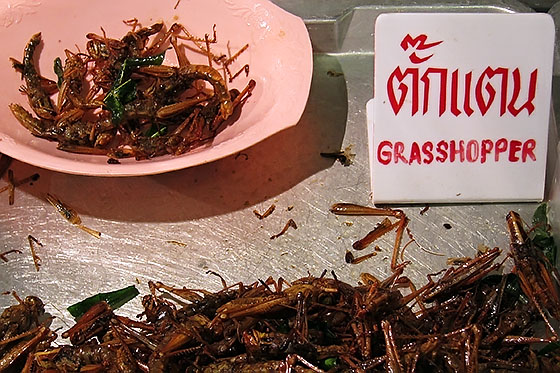Thailand - Food Page 1
Most Thai Food Isn't
The dishes that most people associate with Thailand don't actually have their origins in Thailand. The flat noodle dish, Pad Thai, is one such example. It only became popular in Thailand in the 1930's. With bean sprouts and tofu it is much more like Chinese food, and that's because it comes from China.
Thai cuisine is rice-based and the noodle dishes that can be found everywhere all have their origins in China. The promotion of rice noodles was the brainwave of the military dictator, Plaek Phibunsongkhram, who introduced some very strange nationalistic policies in Thailand, including his Thai cultural mandates.
Chilis are synonomous with Thai food and can be found in almost every dish, but they are native to South America and were taken to Asia by Portuguese navigators.
What could be more Thai than the spicy papaya salad som tum? Except, that chilis, tomatoes, papaya and peanuts all come from the Americas.
More Than Just Sustenance
Thailand is occasionally compared to France. The land mass is about the same and sometimes Thais demonstrate the same stubborn national pride as the French. The Thai obsession with food is another similarity.
The Thai equivalent of "How's it going?" is "Gin khao reu yung?" - "Have you eaten (rice) yet?". You can reply, "Gin lair-o, krup," - you've already eaten or "Yung mai gin," - not yet. If a Thai has eaten, they will sometimes answer that everything is riep roi.

Pad Thai flat noodles
Bear in mind that for many Thai words there are formal and informal versions (there is also special royal vocabulary, and some words are set outside for monks). The word gin (verb 'to eat') is informal and sometimes considered a little rude depending on who you are speaking to. Instead of gin, you will also hear taan.
This simple phrase says a lot about the attitude Thais have towards food. For a start, it tells us what the staple of the Thai diet is. They don't just ask have you eaten but have you eaten rice. Asking you how you are is based on whether you have food in your stomach or not. The Thai way of thinking says that if you have eaten you will be happy and content. If you haven't eaten yet, well ... you need to eat soon!
In Thailand eating tasty food and having a full stomach is not just about keeping the hunger pangs away, it's an integral part of being happy and content in life.
Thais are hugely enthusiastic about food, especially Thai food. "Aroi" (delicious) is a word you will become very familiar with in Thailand. Whenever I am offered food in Thailand (which happens all the time) there are always encouraging comments of, "Aroi, aroi" as the food is passed to me. After and during every meal Thais will continually ask, "Aroi mai?" (Is/was it delicious?).
If I travel anywhere with my girlfriend and the journey is more than an hour she will pack food. I would never bother myself, I'm happy to buy food whenever the opportunity arises, but she has to have a supply of her own.
I was waiting in the departure lounge at Changi airport in Singapore for a flight back to Hat Yai. To pass the time I surfed the Internet for a while on the free terminals provided at Changi. Some Singaporeans waiting for the flight read their newspapers, worked on their laptop computers or waited patiently for boarding to begin.
There was a fairly large Thai family sitting near me. No sooner had they sat down when Mum broke out the food. She had a big box of what looked like Chinese pastries. As the box was handed around I heard lots of encouraging, "Aroi's". They then started to devour the pastries and this elicited lots of, "Aroi maak's". It was a lovely sight. After just a week in Singapore I was desperate to get back to Thailand and this was one of the reasons why. I sat there laughing to myself knowing that people probably thought I was mad but I didn't care.
Here's another anecdote about Thais and food. A Thai friend of mine sent me an e-mail with the subject 'Amazing Japanese Food'. It was a typical e-mail from a Thai and if your e-mail address falls into the hands of Thai friends you will understand what I mean.
The message had been forwarded to a million Thais already; all with very cute Hotmail addresses such as verysexynoi@hotmail.com although this particular Noi had probably never had sex in her life and the thought of doing so would horrify her.
Whenever I receive an e-mail from one of my Thai friends it is necessary to scroll down half a mile first before getting to the actual message because it has already been forwarded so many times and the message is normally a picture of a cute cat or some very 'uplifting' and 'heart-warming' anecdote straight from a born-again Christian in the USA that I delete straight away.

Asians love the bits that Westerners normally throw away
I wondered what this e-mail might contain. To be worthy of sending to so many people it had to be pretty weird I thought. Perhaps a group of Japanese sitting around a live monkey in the middle of the table with the top of its skull sliced open as they dip bread into it's brain?
It was no such thing. The pictures were of normal food; the kind of thing I see at the local branch of Fuji. The food was completely ordinary (ahaan tamada in my books) but was exciting enough for the Thais to send around the Internet apparently.
The only photo of note was one of bowls of strawberries and cream but, I have to admit, I was still fantasising over verysexynoi@hotmail.com at the time and doing my best to imagine a Thai version of Nine and a Half Weeks where Noi first gets smothered in som-tum before the desserts make an appearance.
Grasshoppers
The photo at the top of the page is not representative of a normal Thai meal! I don't actually know any Thais who admit to eating insects but obviously quite a few do otherwise there wouldn't be so many for sale at the markets. I just thought it was a more interesting picture than a bowl of rice.
At the agricultural fair which is held once a year where I live there is no shortage of deep fried insects for sale. Although I find looking at them quite interesting, I can't imagine eating any. The Thais tell me they are healthy and that they are packed full of protein. A homosexual man who tried to hit on me many, many years ago told me the same thing about semen but funnily enough I have no desire to try that either.

Munching into a juicy, deep-fried grasshopper
The gentleman in the photo here did his best to convince me to try a fried grasshopper but sadly, when it comes to food I am not very adventurous. This was not a staged photo. I asked to take his photo as he was tucking into the bag of tasty snacks he had just purchased.
There was an amusing little story in Malaysia's Star newspaper in November 2004. A swarm of locusts had invaded the Red Sea resort town of Eilat in Israel from North Africa. It sounded like a Biblical plague and everyone was quite horrified as the 10cm long insects filled the air devouring everything in sight. Everyone, that was, apart from some Thai labourers working there.
Rather than being horrified, the Thais (who were probably from Isaan) just regarded the new arrivals as free food; collecting them and taking them home to eat. Something I didn't know was that locusts are the only insects regarded as kosher and therefore the only insects that can be eaten under Jewish religious law - not that it mattered much to the Thais.
Thai Eating Habits
One of the things you notice is that Thai people don't cook much for themselves. I have viewed condominiums in Thailand where there are nice bedrooms, bathrooms and living areas but no kitchen. In some there has been a small area where a work top could be added and a small kitchen put together but it is not part of the original design. This would be unthinkable in the West. An expat couple I was talking to had been looking to rent a house but couldn't find one that had an oven.
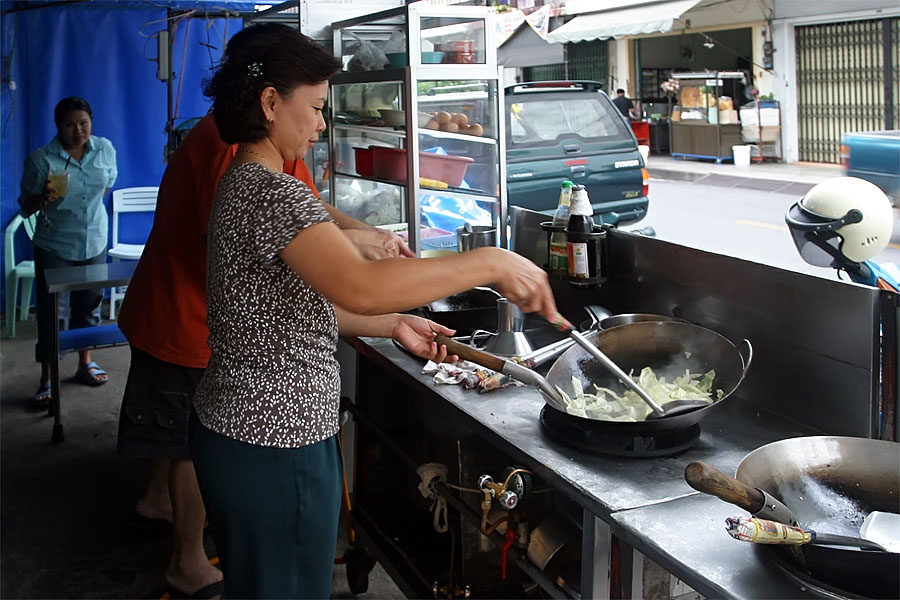
Delicious, freshly cooked food is available everywhere in Thailand for ridiculously cheap prices
The reason for this is that Thais like to buy ready-cooked food and it is available everywhere for very little money. There isn't a place I've visited in Thailand that doesn't have an abundance of street food. Some of the vendors set up their stalls at the same location every day and some are mobile. Even the poorest people will buy rice or som-tum from a vendor and in a lot of cases it would probably cost more to buy the ingredients separately to make the dish rather than to buy it. To give you an example of costs I will describe just a few vendors a few yards away from where I live in Thailand.
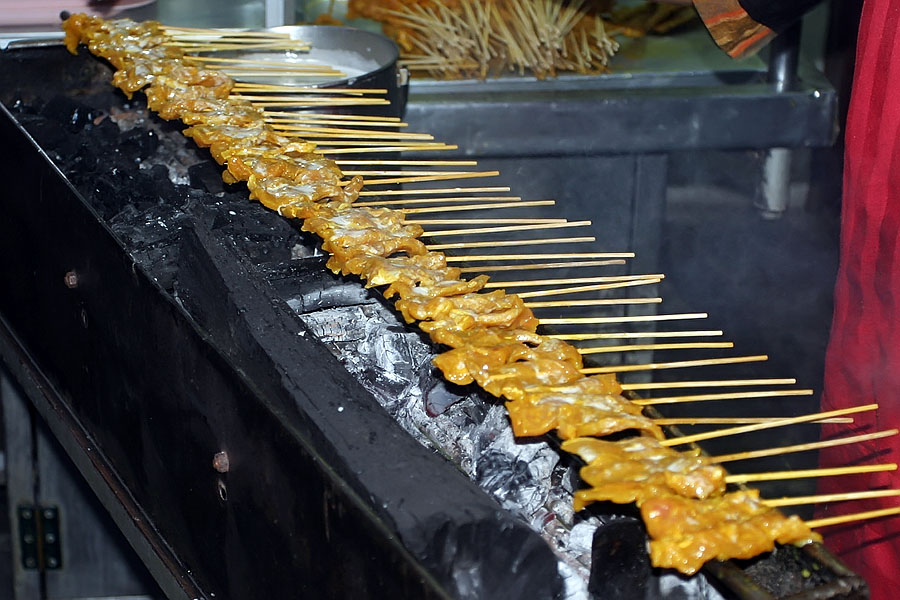
Satay
One vendor prepares som-tum (spicy papaya salad) and laap-muu (spicy minced pork). A portion of som-tum with the usual accompaniments is Bt20. Another vendor sells pork satay. A stick of satay is Bt2. If I have a delicate stomach from eating too much spicy food I like a bowl of khao-tom-plaa (fish and rice soup), which costs Bt40. On those occasions where I want something sweet for a dessert I can buy a banana pancake with condensed milk and sugar for Bt10. Where I buy the soup, som-tum and satay they provide me with a cup of free hot tea so some days I might only spend Bt60 on my evening meal.
As I indicated in the paragraph above, street food is sold by vendors who normally specialise in one dish or a small selection of dishes. Even in many restaurants, especially in the provinces, the selection of food available isn't that great. Bangkok is a bit of an exception. If you want a particular dish it is often necessary to know where you can buy that dish.
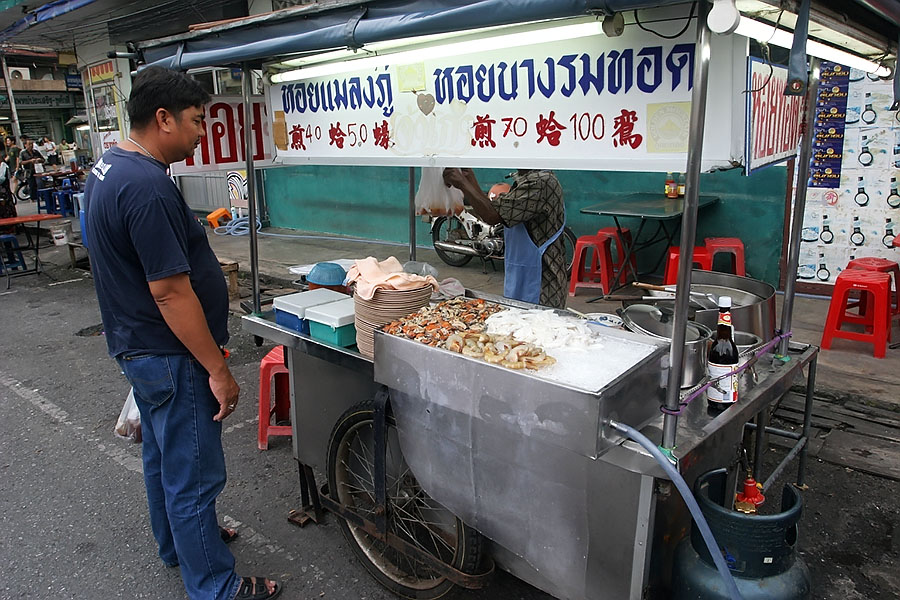
Street vendor selling deep fried shellfish
Hygiene conditions at street vendors don't always appear to be too clever but I have never had a problem eating street food. I have only had three problems from eating food in Thailand. One was on my first visit to Thailand when I got food poisoning from eating a crab but it seemed strange that my two Thai dining companions suffered no ill effects. The second was from eating a western style Thai sandwich from an expensive outlet in an upmarket shopping centre and the third was after eating a dodgy fish.
I sometimes eat alone. This is quite a weird thing in Thailand and you don't see many Thais eating by themselves. A lot of Thais work ridiculously long hours so tend to eat with their work colleagues at their workplace rather than leaving work at 5:30pm going home and eating with their family.
From what I can make out there doesn't seem to be a lot of prior organisation about what they will be eating or with whom. Obviously they need to be hungry but generally Thais are always hungry! The cue might just be a mobile street vendor turning up outside. One of them will see it, go to get the food and whoever is around will join in. For Thais, eating is more than just sustenance, it's a bonding experience too.

Mango and sticky rice
Once the food has arrived at the table people will take a little at a time and eat it before taking more. It's not like the West where we put the whole meal on the plate to begin with. Desserts are not a normal part of the meal and authentic Thai restaurants do not serve them.
Street vendors, like the banana pancake vendor I mentioned above, sell sweet dishes and another favourite is sticky rice with mango (khao niaow ma muang). The picture shows a street vendor selling this particular dessert. Restaurants in Bangkok and other tourist areas will serve desserts though.
To the group of coiffured, northern-English tourists who looked and sounded like they had come straight from the Rovers Return who I saw in Bangkok on my last visit there, Thais do not use chopsticks when eating Thai food. They use a spoon in their right hand to feed themselves with and a fork in their left hand to push food on to the spoon with. An exception is in north-east Thailand where many rural folks eat with their fingers. If you eat Chinese or Japanese food then it is quite acceptable to use chopsticks and they will be provided.
Thai meals don't change much regardless of the time of day, unlike Western food. It's not uncommon at all to see Thais tucking into hot, spicy dishes and offal for breakfast. In some of the outlying regions this is something that can cause a problem for Western visitors. I could eat some of these dishes after lunch but my stomach is too delicate first thing in the morning. In the provinces the thing I get asked most for by visiting farangs who stop me in the street is where they can get bread and eggs for breakfast.

Western style breakfast
Western style breakfasts are available even outside of tourist areas but normally only in Chinese run restaurants. The picture shows what I eat for breakfast two or three times a week from one of my local restaurants. It's a little different from what you might get in a greasy spoon café in the West End of London but it's not bad at all.
You may have noticed glasses of orange juice in pictures on this page. Many restaurants serve it fresh. When you order a fresh orange juice (naam som kan) they will squeeze the oranges there and then.
Annoying Thai Eating Habits
- Being told what to eat
- Over-ordering
- Inappropriate snacking
I can never remember a time in my life when I needed to be told what and when to eat. In Thailand, however, I am constantly being told what to eat. Also, after lots of practice, I am quite good now at knowing what food I like to eat, and what food I don't.
I really don't need to be told what to eat, and I object strongly to being told to eat things that I know I won't like. Advice to tourists when offered food in Thailand would be to eat a little just to avoid causing offense.
I'm not a tourist and - to be honest - I don't care if I do cause offense. I am well past that stage now.
I don't like the taste or smell of sticky rice in any shape or form and generally I don't like Thai desserts. I quite frequently find myself in a situation where a Thai has a sticky rice dessert and is trying to force-feed me while telling me how delicious it is.
While this is happening, all the other Thais are looking to see what happens. They all look hurt and disappointed when I refuse to eat, but that's tough.
I would love to get hold of some really mature, strong smelling blue Stilton cheese and do the same with Thais to see how they like it.
On one occasion a group of Thais I was with got hold of a bag of red ant eggs and tried to do the same thing. I'm sorry if I sound fussy but I just don't need this type of thing at this stage of my life.
You won't see any people more excited than hungry Thais when they arrive at a restaurant. As they peruse the menu, everyone will start to order food. They always order far more than they can eat.
As you attempt to make your way through the food, more and more dishes continue to be delivered to the table. It gets to a point where eating is no longer any fun because your stomach is so full and you start to feel sick.
It is seen as something of a sin to waste food in Thailand. When your Thai dining companions realise that they can't eat everything, they then start trying to force you to eat the food that they over-ordered. It is bloody annoying.
To ease their consciences, they ask for doggy bags so that they can take the left-over food away. It then gets thrown away or fed to some of Thailand's many stray street dogs.
You have told your Thai girlfriend that you are going to an expensive restaurant; or it could be that you are preparing a meal yourself at home.
Just before you are about to eat, she buys a bag of sticky rice things wrapped in banana leaves, or some fried insects or something, from a street stall for Bt20.
She stuffs herself with the Bt20 snack and then, at the fancy restaurant, or when you put the meal you have painstakingly prepared in front of her, she just looks at it without any interest because whe is no longer hungry.
It is at times like this when you think, "Why do I bother?"
Soup
Soup is popular in Thailand but it is eaten differently to how soup is eaten in Western countries. It comes with the main meal and not as a starter. One big pot of soup is put on the table for everyone rather than serving individual bowls. What is in the soup - the meat and vegetables - is eaten rather than the soup itself.

Food offerings at a Chinese Buddhist temple in Songkhla
Dtom yum goong the spicy and sour shrimp soup with lemongrass is probably the best known Thai soup of all. It can be ordered with chicken (dtom yum gai) or seafood (dtom yum tha-lay). Seafood normally consists of shrimps and squid with maybe some mussels thrown in. Tom yum, depending how it has been prepared can be much too spicy for me. I like the taste but it can set my mouth on fire and set the other end on fire the next morning.
Dtom kaa gai is much more to my liking and actually is one of my very favourite Thai dishes. It's made with coconut milk and galangal (similar to ginger root). The coconut milk gives it a lovely creamy taste and if it is prepared properly it has a lovely bite without being too fiery hot.
Do Thais Eat Rats and Dogs?
This isn't a joke or something to enforce racial stereotypes, it's a genuine question that pops up from time to time. The answer in general is no, they don't. However, in certain parts of Isaan, canines and rodents are eaten.

Thailand temple dog
Eating dogs is illegal in Thailand but the fact that any activity is illegal doesn't make much difference with the general Thai disregard for laws. The practice goes on mainly in the north-eastern province of Sakhon Nakhon. Dogs are rounded up to be slaughtered and sold at the local markets or exported to neighbouring countries where people also have a taste for mutts. I guess it's one way of keeping the Thai stray dog problem in check.
A highly educated Thai friend informs me Buddhist Thais do not eat dog meat, but that it only occurs in small Christian villages around Sakhon Nakhon. How true this is, I don't know.
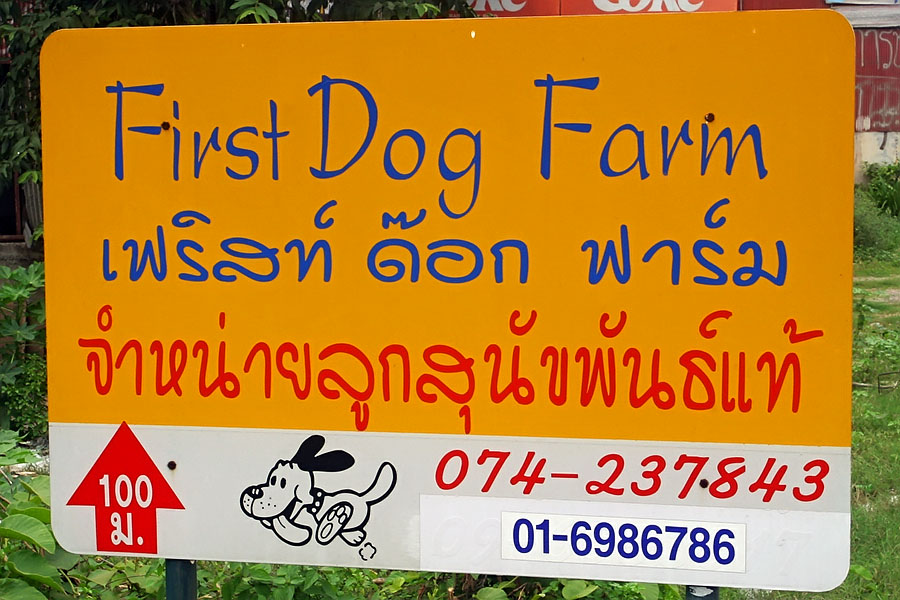
I believe this dog farm provides pets, rather than food
North-eastern Thais also have an affinity for rodents but not the huge rats that can be seen scurrying in and out of storm drains all over the country. They eat what I imagine would be called field-mice elsewhere. What doesn't help with general perceptions is that there is only one generic term used for any mouse or rat-like creature - nuu.
Eating rats is obviously disgusting (and, I would imagine quite dangerous) but eating mice that have been living on a diet of corn is probably no worse than eating other rodents, such as rabbits, and I have eaten plenty of rabbits in my time.
Hygiene
At the Fuji chain of Japanese restaurants in Thailand, all kitchen staff wear aprons, hats and face masks. On one occasion I spoke to a chef who works there and he told me that every month the kitchens are completely emptied and sprayed with insecticide. There are probably no cleaner kitchens elsewhere in the world.
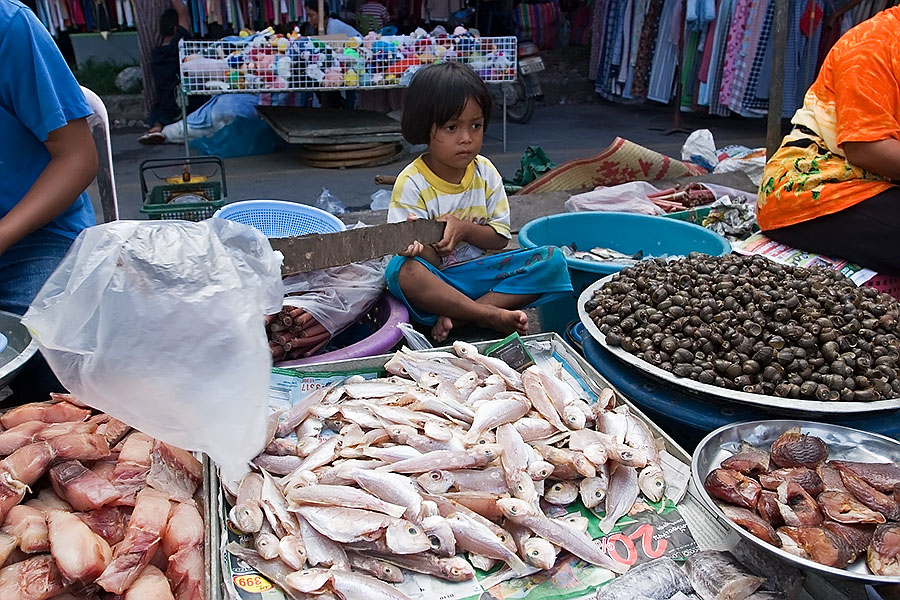
Trying to keep flies off fish at a Thai fresh market
However, the Fuji chain (unfortunately), is a major exception. On several occasions, I have been shocked and appalled at what I have seen (and what I have seen is no doubt only the tip of the iceberg). Quite frankly, food hygiene in Thailand leaves a lot to be desired.
It starts at the fresh markets where meat is sold uncovered and unrefrigerated. Even if you don't buy food directly from the fresh markets, this is where many small restaurants get their supplies from. Sitting in tropical temperatures, it is usual for the meat to be covered in flies. Sometimes the vendor will make a half-hearted attempt to keep the flies off by waving around a stick with a plastic bag tied to the end.
Many small restaurants swarm with flies during the daytime. No attempt is made to keep them out of the restaurant, no attempt is made to keep them off the food, and no attempt is made to kill them. The food preparation surface is a favourite place for flies when the cooking isn't working there.

Thai fresh market in Chiang Mai
Brown rats originated from Asia and were carried to other parts of the world by ship. Seeing a rat in England was a fairly unusual event but in Thailand I see rats almost every single day of my life. I usually see them out on the streets foraging in garbage bins for food but it is not unusual to see them in restaurants.
I once ate at a restaurant where the kitchen had a major rat infestation. Unfortunately, I didn't spot the problem until after I had eaten. The three young members of staff showed no reaction when I told them. Obviously, they already knew about the problem but just continued to prepare food.

Flies on food
Thais are remarkably tolerant of things that would 'gross out' many Westerners. At one food centre I ate at in a major department store there were cockroaches crawling over the cutlery tray when I went to get a fork and spoon with which to eat my rice.
If a Thai spots a cockroach they will just brush it off - end of story. Rats are also no big deal even though Leptospirosis, which can be caught from rat urine is a serious, life-threatening disease.
In Phuket many years ago, as a tourist, I remember being quite shocked by seeing a rat in a restaurant and then finding a sandwich I had been served was full of ants. The waitress was irritated when I mentioned it. She took it back to the kitchen where I think she just brushed the ants off before giving it back to me.
Some years ago a couple of Thais were attempting to sue the Hat Yai branch of Sizzler after eating steaks full of maggots.

Fly swatters are sold alongside kitchen equipment
I have stopped eating at certain local restaurants because of flies on the food. Evenings are generally OK because there aren't many flies around but I had a shock after visiting a few places at lunchtime and seeing the food and preparation surfaces absolutely covered with flies.
Although I was disgusted, Thais think nothing of flies on food and take no measures to protect the food. Flies are associated with food and fly swatters are sold along with kitchen equipment.
Thailand is aware of its hygiene problems and there is a special government department for food hygiene but what you have to remember is that Thailand is the land of image, face and rhetoric; not of substance or action. You might hear or read about what is being done about food hygiene, and you might see signs in restaurants that say 'Clean Food - Good Taste', but what you won't see are regular health inspections or restaurants that have been shut down because of poor hygiene.
Having said all this, I have only had food poisoning in Thailand four of five times - which is fairly good - and only on two occasions did I need hospital treatment. Interestingly, the places you might suspect as being the worst offenders aren't necessarily that bad.

Clean food good taste
Many street vendors keep their uncooked meat in ice boxes and it goes straight to a sizzling wok that is so hot it will kill most bugs instantly. A seemingly clean restaurant where food is prepared on the same work surfaces that rats have been using as a toilet is far more dangerous. Outward appearances can be very deceiving when the real problem can only be seen with a microscope.
What precautions can you take? Unfortunately, food poisoning in Thailand is a bit of a gamble. You could eat at Fuji every day but that would probably get boring after a while. If you want to prepare your own food, buying from one of the big supermarkets should be less risky than from a fresh market.
Upmarket restaurants and hotels should have higher standards of hygiene but don't count on it. It's not something to get paranoid about but insects, cockroaches and rats alongside food is normal for Thailand. If you visit or decide to live in Thailand, get used to it.
The Nation published the following on 17th June 2006:
Coliform bacteria have contaminated utensils at many food shops around tourist attractions, according to the Health Department."The contamination can cause diarrhoea and food poisoning," the department's academic Anocha Charoenpornkijwattana said Sunday.
According to her, the information came from the Health Department's study on hygienic standards at 12 attractions across the country. As more than half of food shops in these attractions have participated in the department's 'Clean Food Good Taste' project, the study focused on the non-participating food shops only.
"We have detected coliform-bacteria contamination on their plates, ice tongs, cooks' hands and waiters' hands," Anocha said.
Som-tum Roulette
I mentioned above that so far I have never been sick after eating from a street vendor. It would appear I've been lucky. The Nation continues to offer little gems and I found the following facts in the 14 August 2004 edition.
For background, som-tum is the spicy papaya salad that is very popular in Thailand. It is sold everywhere, often by street vendors who make it fresh while you wait. They shred the papaya, mix the ingredients and then pound it all up using a mortar and pestle. It normally costs around Bt20 per portion.
In the survey 95% of the shrimp ingredients were artificially coloured and 67% of the prepared salads had foreign bodies in them. Fifteen per cent of the peanuts were contaminated with fungus. Twenty out of thirty samples of prepared som-tum had agents and microbes that could cause food poisoning.

